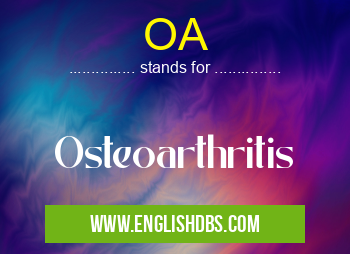What does OA mean in DISABILITY
Osteoarthritis (OA) is a type of joint disease caused by the breakdown of cartilage, the tissue that covers and protects the ends of bones. It most often occurs in adults aged 45 and older. Symptoms range from mild inflammation and stiffness to severe pain, limited mobility, and difficulty performing everyday activities. Treatment options include lifestyle changes, physical therapy, medications, and surgeries.

OA meaning in Disability in Medical
OA mostly used in an acronym Disability in Category Medical that means Osteoarthritis
Shorthand: OA,
Full Form: Osteoarthritis
For more information of "Osteoarthritis", see the section below.
» Medical » Disability
Definition
OA is an abbreviation for Osteoarthritis - a degenerative joint disease which causes inflammation in many joints in the body such as knees, shoulders, hips and elbows; this condition affects mainly adults over 45 years old. OA is characterized by joint stiffness, swelling and pain that typically worsens with age. In addition, movement can become more difficult due to decreased flexibility or weakened surrounding muscles.
Causes
The exact cause of OA can be difficult to pinpoint but certain factors have been linked to its development such as obesity, aging, genetics/family history and previous injury or trauma to the joint. Prolonged use of a particular joint can also increase the risk of developing osteoarthritis overtime.
Symptoms
Common symptoms associated with OA include tenderness in the joints while moving or being touched; persistent stiffness especially upon getting out of bed or after sitting for long periods; pain worsening as time progresses; swelling around affected joints; grating or grinding sensation when applying pressure on affected area; reduced range of motion due to pain or weakness; cracking sound when bending knees or other affected joints.
Diagnosis
To diagnose OA your doctor will first review your medical history including any injuries sustained before presenting symptoms along with a physical exam assessing range-of-motion in your joints followed by imaging tests such as X-ray's or magnetic resonance imaging (MRI) to detect any damage within the affected cartilage areas.
Treatment
Treatments are based on managing pain levels effectively while also trying to reduce further damage caused by OA such as lifestyle changes like losing weight if overweight along with exercising regularly (but not excessively) as this helps relieve stress off sensitive areas while also strengthening muscles surrounding them thus providing stability and support. Other treatments may include medications such as NSAID's (nonsteroidal anti-inflammatory drugs), prescribed steroids injections into joints for targeted relief along with physical therapy that helps improve flexibility while lessening inflammation through ice/cold packs application directly onto skin over sore areas. Surgery is sometimes required to replace damaged joint cartilage while artificial implantation may be needed for severely worn away cartilage.
Essential Questions and Answers on Osteoarthritis in "MEDICAL»DISABILITY"
What is Osteoarthritis?
Osteoarthritis is a degenerative joint disease that affects the cartilage between bones, resulting in pain and stiffness. Over time, it can lead to difficulty with everyday activities such as walking, bending or climbing stairs.
Who is most likely to have Osteoarthritis?
Osteoarthritis can affect any age group, but it is more common in adults over the age of 55. People who are overweight or have had a previous injury to the joints are more likely to develop osteoarthritis.
How does Osteoarthritis cause pain?
When the cartilage between two bones breaks down due to wear-and-tear over time, this exposes nerves which can be painful when touched. The surrounding muscles may also become tense from trying to protect the joint from further damage.
What are some treatments for Osteoarthritis?
Treatment typically involves lifestyle modifications such as weight loss if needed and exercising regularly to keep your joints flexible and strong. Over-the-counter medications can help reduce inflammation and ease pain. Physical therapy or hot/cold packs may also be recommended. In severe cases, surgery may be necessary.
Are there any home remedies I can use to treat my Osteoarthritis symptoms?
Yes! There are many lifestyle changes you can make such as taking frequent breaks throughout the day and using heat or cold therapy on affected areas before activities that cause pain. Maintaining healthy body weight and eating anti-inflammatory foods has also been known to help manage the symptoms of osteoarthritis.
Are there any supplements I should take for my Osteoarthritis?
Supplements such as glucosamine sulfate, chondroitin sulfate and omega-3 fatty acids may be helpful in reducing swelling and stiffness associated with osteoarthritis; however it's important to speak with your healthcare provider before starting any supplement regimen. Many foods also contain these same nutrients so dietary changes may be a good place to start first!
Is physical activity safe with Osteoarthritis?
Exercise is an important part of managing osteoarthritis symptoms; however it's important to speak with your healthcare provider before starting any exercise program as they will be able to suggest what types of exercise would be beneficial for you at your current stage of osteoarthritis development.
Why is it important not to smoke if I have Osteoarthritis?
Smoking has been linked to higher levels of inflammation in people with arthritis which could worsen their condition overtime so quitting if necessary should remain a priority when managing one's health.
Final Words:
Osteoarthritis is a painful progressive condition affecting many adults over 45yrs old but luckily it doesn't result in permanent disability if treated quick enough through combined methods like diet & exercise modifications alongside medications & therapy sessions designed for tackling inflammation & promoting stabilization thus avoiding any need for surgery down-the-line if possible.
OA also stands for: |
|
| All stands for OA |
